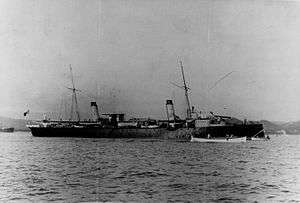Italian cruiser Urania
Urania was a torpedo cruiser of the Partenope class built for the Italian Regia Marina (Royal Navy) in the 1880s. She was built by the Cantieri navali Odero shipyard; her keel was laid in February 1889, she was launched in June 1891, and was commissioned in July 1893. Her main armament were her six torpedo tubes, which were supported by a battery of ten small-caliber guns. Urania spent most of her career in the main Italian fleet, where she was primarily occupied with training exercises. She was still in service at the outbreak of the Italo-Turkish War in September 1911, but she did not take part in any operations. Instead, she remained in Italian waters and was broken up for scrap in January 1912.
 Urania shortly after entering service, c. 1893–94 | |
| History | |
|---|---|
| Name: | Urania |
| Namesake: | Urania |
| Builder: | Cantieri navali Odero, Genoa |
| Laid down: | 16 February 1889 |
| Launched: | 18 June 1891 |
| Commissioned: | 21 July 1893 |
| Fate: | Sold for scrapping January 1912 |
| General characteristics | |
| Class and type: | Partenope-class torpedo cruiser |
| Displacement: | Normal: 931 long tons (946 t) |
| Length: | 73.1 m (239 ft 10 in) |
| Beam: | 8.22 m (27 ft) |
| Draft: | 3.48 m (11 ft 5 in) |
| Propulsion: |
|
| Speed: | 18.1 to 20.8 knots (33.5 to 38.5 km/h; 20.8 to 23.9 mph) |
| Range: | 1,800 nautical miles (3,300 km; 2,100 mi) at 10 knots (19 km/h; 12 mph) |
| Complement: | 96–121 |
| Armament: |
|
| Armor: |
|
Design
Urania was 73.1 meters (239 ft 10 in) long overall and had a beam of 8.22 m (27 ft) and an average draft of 3.48 m (11 ft 5 in). She displaced 931 long tons (946 t) normally. Her propulsion system consisted of a pair of horizontal triple-expansion steam engines, each driving a single screw propeller, with steam supplied by four coal-fired locomotive boilers. Specific figures for Urania's engine performance have not survived, but the ships of her class had top speeds of 18.1 to 20.8 knots (33.5 to 38.5 km/h; 20.8 to 23.9 mph) at 3,884 to 4,422 indicated horsepower (2,896 to 3,297 kW). The ship had a cruising radius of about 1,800 nautical miles (3,300 km; 2,100 mi) at a speed of 10 knots (19 km/h; 12 mph). She had a crew of between 96–121.[1]
Urania was armed with a main battery of one 120 mm (4.7 in) /40 gun and six 57 mm (2.2 in) /43 guns mounted singly.α She was also equipped with three 37 mm (1.5 in) /20 guns in single mounts. Her primary offensive weapon was her six 450 mm (17.7 in) torpedo tubes. The ship was protected by an armored deck that was up to 1.6 in (41 mm) thick; her conning tower was armored with the same thickness of steel plate.[1]
Service history
Urania was laid down on 16 February 1889 at the Cantieri navali Odero (Odero Shipyard) in Genoa, and was launched on 18 June 1891. After fitting-out work was completed, the ship was commissioned into the fleet on 21 July 1893.[1] During the 1893 fleet maneuvers, Urania served with the 2nd Division of the Reserve Squadron, along with the ironclad Castelfidardo, the protected cruiser Stromboli, and four torpedo boats. During the maneuvers, which lasted from 6 August to 5 September, the ships of the Reserve Squadron defended against a simulated attack by the Active Squadron, which gamed a French attack on the Italian fleet.[2] In 1895, Urania was stationed in the 2nd Maritime Department, split between Taranto and Naples, along with most of the torpedo cruisers in the Italian fleet. These included her sister ships Partenope, Aretusa, Euridice, Iride, Minerva, and Caprera, the four Goito-class cruisers, and Tripoli.[3]
The ship was assigned to the 2nd Division of the main fleet in 1897, along with the three Ruggiero di Lauria-class ironclads and the protected cruisers Etna and Stromboli.[4] In 1899, Urania was assigned to the 2nd Division of the main fleet, which consisted of the ironclads Affondatore, Castelfidardo, and Sicilia and her sister ship Partenope. The 2nd Division was usually kept in reserve, which amounted to three months of active service per year, with the rest of the time spent in harbor with reduced crews.[5] At the start of the Italo-Turkish War in September 1911, Urania was stationed in Italy, alternating between the ports of La Spezia and Naples, along with her sister ships Iride and Caprera. She did not see action during the war.[6] In January 1912, with the war still on-going, the ship was sold for scrap and thereafter broken up.[1]
Notes
- ^α "/40" refers to the length of the gun in terms of calibers, meaning that the length of the barrel is 40 times its internal diameter.
- Gardiner, p. 347
- Clarke & Thursfield, pp. 202–203
- "Naval and Military Notes – Italy", p. 90
- Robinson, p. 187
- Brassey, p. 72
- Beehler, p. 9
References
- Beehler, William Henry (1913). The History of the Italian-Turkish War: September 29, 1911, to October 18, 1912. Annapolis: United States Naval Institute. OCLC 1408563.
- Brassey, Thomas A., ed. (1899). The Naval Annual. Portsmouth: J. Griffin & Co. OCLC 5140928.
- Clarke, George S.; Thursfield, James R. (1897). The Navy and the Nation, or Naval Warfare and Imperial Defence. London: John Murray. OCLC 669157022.
- Gardiner, Robert, ed. (1979). Conway's All the World's Fighting Ships: 1860–1905. London: Conway Maritime Press. ISBN 0-85177-133-5.
- "Naval and Military Notes – Italy". Journal of the Royal United Service Institution. London: J. J. Keliher. XXXIX: 81–111. 1895. OCLC 8007941.
- Robinson, Charles N., ed. (1897). The Navy and Army Illustrated. III (32). London: Hudson & Kearns. OCLC 7489254.